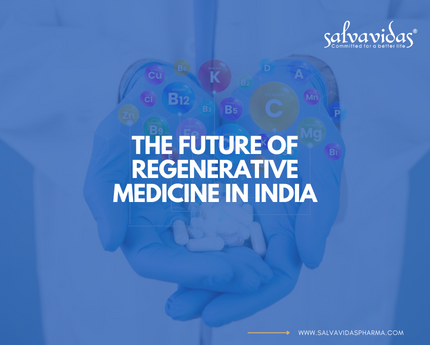
The Future of Regenerative Medicine in India
Introduction:
Regenerative medicine is a rapidly advancing field that has the potential to transform the way we treat a wide range of diseases and injuries. This innovative approach to medicine focuses on using the body’s own natural processes to repair, replace, or regenerate damaged or diseased tissue. In India, regenerative medicine is still a relatively new field, but it is rapidly gaining ground thanks to the growing awareness and investment in healthcare innovation.
- Current Landscape of Regenerative Medicine in India
- Promising Developments in Regenerative Medicine
- Challenges to the Adoption of Regenerative Medicine in India
- Opportunities for the Future of Regenerative Medicine in India
- Key Players in the Indian Regenerative Medicine Market
- Frequently Asked Questions About Regenerative Medicine in India
Stem Cell Therapy
Stem cell therapy is a medical treatment that involves the use of stem cells to repair or replace damaged or diseased tissues in the body. Stem cells are unique cells that have the ability to divide and differentiate into various types of cells, including muscle cells, bone cells, and nerve cells.
There are two types of stem cells used in therapy: embryonic stem cells, which are derived from embryos, and adult stem cells, which are found in various tissues throughout the body, such as bone marrow and fat tissue.
Stem cell therapy has shown promise in treating a variety of conditions, including heart disease, diabetes, and Parkinson’s disease. However, it is still a relatively new and experimental field, and more research is needed to fully understand its potential benefits and risks.
Additionally, there are ethical concerns surrounding the use of embryonic stem cells, as they require the destruction of embryos. As a result, many researchers are focusing on the use of adult stem cells, which can be obtained from a patient’s own body, reducing the risk of rejection and ethical concerns.
Tissue Engineering
Tissue engineering is a field of biomedical engineering that involves the creation of living, functional tissues for medical applications. It involves combining cells, scaffolds, and signaling molecules to produce three-dimensional structures that can be implanted into the body to replace damaged or diseased tissue.
The process of tissue engineering typically involves the isolation of cells from the patient or donor, the seeding of these cells onto a scaffold material, and the application of growth factors and other signaling molecules to induce the cells to differentiate and form new tissue. The resulting tissue construct is then cultured in the lab until it is mature enough to be implanted into the patient.
Tissue engineering has the potential to revolutionize medical treatments for a wide range of conditions, including burns, heart disease, and spinal cord injuries. However, there are still many challenges to be overcome before tissue engineering can become a widespread clinical reality. These include the need for more effective scaffolds and growth factors, as well as better methods for controlling the growth and differentiation of cells.
Gene Therapy
Gene therapy is a medical approach that involves altering or replacing the genes inside a person’s cells to treat or prevent diseases. The goal of gene therapy is to correct genetic defects or introduce new genes that can help the body fight off disease.
There are different types of gene therapy, but the most common method involves using a virus to deliver the desired gene into the patient’s cells. The virus acts as a carrier or vector that delivers the new gene to the targeted cells.
Gene therapy is still a relatively new field, and research is ongoing to better understand its potential benefits and risks. Some early successes have been achieved in treating rare genetic disorders such as severe combined immunodeficiency (SCID) and spinal muscular atrophy (SMA). However, there are still many challenges to overcome before gene therapy can become a widespread and effective treatment option for a wider range of diseases.
Biologics
Biologics is a type of medical treatment derived from living organisms, such as cells or proteins. They are used to treat a variety of diseases, including cancer, autoimmune disorders, and chronic inflammatory conditions. Biologics are typically administered through injection or infusion and work by targeting specific molecules in the body to block or modify their activity. Examples of biologics include monoclonal antibodies, cytokines, and growth factors. Biologics are often more expensive than traditional pharmaceuticals, but they can also be more effective and have fewer side effects.
Research and Development
Research and development (R&D) refers to the systematic and creative work undertaken to increase knowledge, develop new products or processes, or improve existing ones. R&D is an essential part of innovation, and it plays a crucial role in the growth and success of businesses and economies.
R&D can take many forms, including basic research, applied research, and development. Basic research is focused on exploring new areas of knowledge and understanding fundamental principles, often without a specific application in mind. Applied research involves the practical application of scientific or technical knowledge to solve specific problems or develop new products or processes. Development refers to the process of creating new products or processes or improving existing ones, based on the results of research.
R&D is conducted in a wide range of fields, including science, technology, engineering, medicine, and social sciences. It involves a combination of creativity, scientific rigor, and methodical experimentation to achieve desired results. R&D is often a collaborative effort, involving teams of scientists, engineers, technicians, and other professionals.
R&D is a critical driver of economic growth and competitiveness. It helps businesses to stay competitive by creating new and innovative products and processes, and it contributes to the development of new industries and markets. R&D also plays an important role in addressing some of the world’s most pressing challenges, such as climate change, health care, and food security.
Clinical Trials
Clinical trials are research studies that are conducted on human participants to evaluate the safety and efficacy of new medical treatments, drugs, or devices. These trials are designed to answer specific questions about the safety, effectiveness, and side effects of these interventions.
Clinical trials follow a strict protocol and are conducted in phases, with each phase building on the results of the previous phase. Phase 1 trials usually involve a small number of healthy volunteers and are designed to test the safety of the intervention. Phase 2 trials involve a larger number of participants with the condition being treated, and are designed to determine the effectiveness of the intervention. Phase 3 trials involve even larger numbers of participants and are designed to confirm the effectiveness of the intervention and to compare it to existing treatments.
Clinical trials are essential for advancing medical knowledge and developing new treatments, but they can also present risks to participants. Participants in clinical trials are carefully monitored, and their safety is a top priority. Before enrolling in a clinical trial, participants must provide informed consent and undergo a thorough screening process to ensure that they are eligible to participate.
Commercialization
Commercialization refers to the process of introducing a product, service, or technology to the marketplace for the purpose of making a profit. This involves developing and implementing strategies to market, sell, and distribute the product or service to customers.
Commercialization can involve a range of activities, including research and development, production, marketing, sales, distribution, and customer service. The goal of commercialization is to create value for both the company and its customers by bringing innovative and useful products and services to market.
Commercialization is an important aspect of modern business, as it allows companies to generate revenue and profits that can be used to invest in further research and development, expand operations, and create new jobs. However, it also requires careful planning and execution to ensure that the product or service meets customer needs and is priced competitively in the marketplace.
Regulatory Framework
A regulatory framework refers to the set of laws, rules, and guidelines that govern a particular industry or activity. It is designed to ensure that companies and individuals within the industry comply with certain standards and that consumers are protected from harm. The framework typically includes regulatory agencies, such as government bodies or industry associations, that oversee and enforce the regulations. The regulatory framework aims to balance the interests of all parties involved while maintaining a safe and fair marketplace.
Cost and Affordability
Cost refers to the monetary value or price that is required to purchase or produce something, whether it’s a product, service, or activity. It can also include the resources, such as time and effort, needed to acquire or produce something.
Affordability, on the other hand, refers to the ability of an individual or a group of people to purchase or access something based on their financial resources. It is a measure of whether the cost of something is within a person’s means to pay for it.
Therefore, while cost is the actual amount of money or resources required to obtain something, affordability is a measure of whether that cost is manageable and within the financial means of an individual or group.
Lack of Awareness and Infrastructure
“Lack of Awareness and Infrastructure” refers to a situation where people are not informed or educated about a particular issue or topic, and there is also a shortage of necessary facilities or resources to support that issue.
For example, in the context of healthcare, a lack of awareness could mean that people are not aware of the importance of getting vaccinated or seeking medical attention when they feel unwell. A lack of infrastructure could refer to a shortage of hospitals, medical equipment, or trained healthcare workers in a particular area.
Similarly, in the context of environmental conservation, a lack of awareness could mean that people are not educated about the impact of their actions on the environment. A lack of infrastructure could refer to a shortage of recycling facilities, public transportation options, or renewable energy sources.
In general, addressing the lack of awareness and infrastructure requires efforts to educate people and provide them with the necessary resources and facilities to support the issue at hand. This could involve initiatives such as public awareness campaigns, investment in infrastructure development, and training programs for professionals in relevant fields.
Medical Tourism and Global Market
Medical tourism refers to the practice of traveling to another country to receive medical treatment or procedures. This industry has experienced significant growth in recent years, driven by a number of factors such as rising healthcare costs in developed countries, long wait times for certain procedures, and the availability of high-quality medical facilities in developing countries.
The global medical tourism market is expected to continue to grow in the coming years, with Asia Pacific and Latin America being identified as the fastest-growing regions. Countries such as India, Thailand, and Mexico have become popular destinations for medical tourism due to their lower costs and high-quality medical facilities.
However, medical tourism also raises concerns about the quality and safety of medical procedures, as well as the ethical implications of traveling to other countries for medical treatment. It is important for patients to thoroughly research their options and carefully consider the risks and benefits of traveling for medical procedures.
Overall, medical tourism has the potential to provide patients with greater access to affordable medical treatment and to drive economic growth in developing countries. However, it is important to approach this industry with caution and to prioritize patient safety and ethical considerations.
How Does Regenerative Medicine Work?
Regenerative medicine is a field of medicine that aims to restore damaged tissues and organs to their normal function. This is achieved by using advanced biological materials, such as stem cells, growth factors, and tissue engineering techniques.
Stem cells are unspecialized cells that have the potential to develop into any type of cell in the body. They can be derived from a variety of sources, including bone marrow, fat tissue, and embryonic cells. Once harvested, stem cells can be cultured in a laboratory and then implanted into a patient’s body to help repair damaged tissues.
What Diseases and Conditions Can Regenerative Medicine Treat?
Regenerative medicine is an emerging field of medicine that involves using the body’s own natural processes to heal and regenerate damaged tissues and organs. This approach has the potential to revolutionize healthcare by offering treatments for a wide range of diseases and conditions. Some of the diseases and conditions that regenerative medicine can potentially treat include:
- Heart disease: Regenerative medicine can be used to repair and regenerate damaged heart tissue, potentially improving heart function and reducing the risk of heart failure.
- Stroke: Regenerative therapies can help to repair damaged brain tissue after a stroke, potentially improving neurological function and reducing the risk of disability.
- Diabetes: Regenerative medicine can be used to regenerate pancreatic cells that produce insulin, potentially offering a cure for diabetes.
- Arthritis: Regenerative medicine can be used to regenerate damaged cartilage and other tissues in the joints, potentially reducing pain and improving mobility.
- Spinal cord injuries: Regenerative therapies can help to repair damaged nerve tissue in the spinal cord, potentially restoring function and improving quality of life.
- Skin damage: Regenerative medicine can be used to regenerate skin tissue, potentially reducing scarring and improving wound healing.
- Liver disease: Regenerative medicine can be used to regenerate damaged liver tissue, potentially improving liver function and reducing the risk of liver failure.
- Lung disease: Regenerative therapies can help to regenerate damaged lung tissue, potentially improving lung function and reducing the risk of respiratory failure.
Overall, regenerative medicine has the potential to treat a wide range of diseases and conditions by harnessing the body’s own natural healing processes. As the field continues to evolve, it is likely that we will see even more applications of regenerative medicine in the future.
Is Regenerative Medicine Safe?
Regenerative medicine is a relatively new field that involves using the body’s own natural processes to repair or replace damaged or diseased tissues and organs. While there have been some promising advances in regenerative medicine, it is important to note that not all treatments are currently proven to be safe or effective.
The safety of regenerative medicine largely depends on the specific treatment being used and how it is administered. For example, stem cell therapies, which are a type of regenerative medicine, have the potential to be both safe and effective, but only if they are properly regulated and administered by qualified medical professionals.
Currently, many clinics are offering unproven and potentially dangerous regenerative medicine treatments. These treatments often make exaggerated claims and may not have undergone rigorous clinical testing or been approved by regulatory agencies. Patients who are considering regenerative medicine treatments should carefully research the treatment and the provider to ensure that they are receiving safe and effective care.
Overall, while regenerative medicine has the potential to be a safe and effective way to treat a wide range of conditions, it is important to approach it with caution and to carefully consider the risks and benefits of any treatment.
What is the Cost of Regenerative Medicine Treatment in India?
The cost of regenerative medicine treatment in India can vary depending on various factors, such as the type of treatment, the severity of the condition, the location of the treatment center, and the expertise of the medical professional performing the treatment.
Generally, regenerative medicine treatments such as stem cell therapy can cost anywhere from INR 50,000 to INR 2,50,000 ($680 – $3400 USD) per session. However, some advanced therapies may cost significantly more.
It is essential to note that insurance coverage for regenerative medicine treatments in India is limited, and patients may have to bear the entire cost of treatment themselves. Therefore, it is advisable to consult with a medical professional to determine the most appropriate treatment for your condition and get an estimate of the associated costs.
Bullet Points:
- Stem cell therapy is the most widely used regenerative medicine approach in India.
- Tissue engineering is a promising area of research, with applications in wound healing, bone repair, and organ replacement.
- Gene therapy is being explored as a potential treatment for genetic disorders, cancer, and HIV/AIDS.
- Biologics, such as platelet-rich plasma and growth factors, are commonly used in orthopedic and sports medicine.
- Despite the progress made in regenerative medicine, there are several challenges to its widespread adoption in India, including regulatory hurdles, high costs, and lack of awareness and infrastructure.
- The Indian government has launched several initiatives to promote innovation and entrepreneurship in healthcare, including regenerative medicine.
- Stempeutics Research, Advancells, and Cryoviva Biotech are among the key players in the Indian regenerative medicine market.
FAQs:
Q: What is regenerative medicine?
A: Regenerative medicine is a field of medicine that uses the body’s own natural processes to repair, replace, or regenerate damaged or diseased tissue.
Q: How does regenerative medicine work?
A: Regenerative medicine works by harnessing the body’s natural ability to heal itself. This can be achieved through the use of stem cells, growth factors, gene therapy, or tissue engineering.
Q: What diseases and conditions can regenerative medicine treat?
A: Regenerative medicine has the potential to treat a wide range of diseases and conditions, including spinal cord injuries, heart disease, diabetes, Parkinson’s disease, and cancer.
Q: Is regenerative medicine safe?
A: While regenerative medicine holds enormous promise, there are still many safety concerns and risks associated with some approaches. It is important to work with qualified and experienced medical professionals to ensure that the treatment is safe and effective.
Q: What is the cost of regenerative medicine treatment in India?
A: The cost of regenerative medicine treatment in India can vary widely depending on the type of treatment, the extent of the disease or injury, and the provider. It is important to do your research and compare costs and providers before making a decision.
Conclusion:
Regenerative medicine is an exciting field that holds enormous potential for treating a wide range of diseases and injuries. In India, this field is still in its early stages, but there have been promising developments and a growing interest in innovation and entrepreneurship in healthcare. Despite the challenges, there are many opportunities for the future of regenerative medicine in India, and with the right support and investment, this field could transform healthcare and improve the lives of millions of people.




0